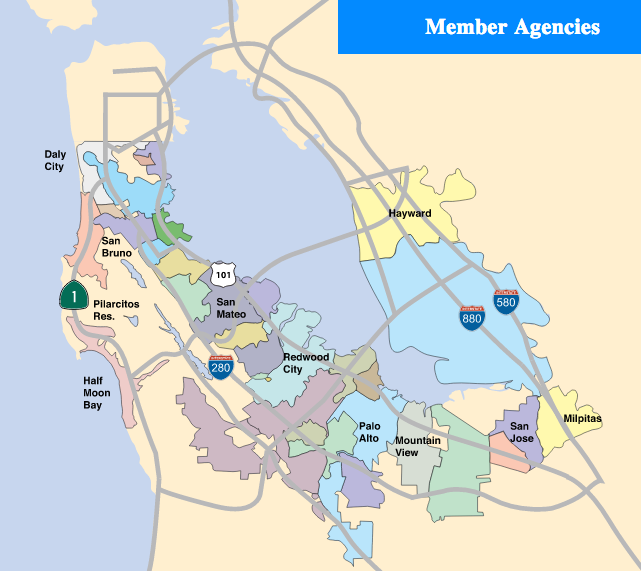 This Thursday, January 19th, the Board of the Bay Area Water Supply & Conservation Agency (BAWSCA)—the umbrella group that purchases Tuolumne River water from the SFPUC to serve many communities in the East and South Bay Area and on the Peninsula—will discuss a State proposal on increasing freshwater flows to the Bay-Delta estuary.
This Thursday, January 19th, the Board of the Bay Area Water Supply & Conservation Agency (BAWSCA)—the umbrella group that purchases Tuolumne River water from the SFPUC to serve many communities in the East and South Bay Area and on the Peninsula—will discuss a State proposal on increasing freshwater flows to the Bay-Delta estuary.
We need to show up and keep the pressure on to save our Bay-Delta estuary. California rivers, the Delta, San Francisco Bay, and the ecosystems that depend on them have been in serious decline, largely due to increasing water diversions for agriculture and industry. As a necessary step toward reversing this decline, the State Water Resources Control Board recently proposed increased freshwater flows for major tributaries of the San Joaquin River, including the Tuolumne—the main source of water for 2.6 million Bay Area residents like you.
Earlier this month action by hundreds of Sierra Club members got the San Francisco Public Utilities Commission (SFPUC) to put higher freshwater flows for the SF Bay-Delta on their agenda. The Commission agreed to discuss their opposition with environmental advocates—an important victory!
WhatYouCanDo
1. Send a message to the board asking them to support higher freshwater flows: Take action here!
2. Attend the BAWSCA Board meeting and speak up:
Thursday, January 19, 2017, 6:30 pm
San Mateo Main Library, San Mateo Oak Room
55 W 3rd Ave, San Mateo, CA 94402
RSVP here!
You will have only a short time to speak. (Read the meeting agenda here.) Best to introduce yourself and state that our river/delta/bay are important to you. You might briefly touch on one or two of the talking points below:
- In the SFPUC service area, water use decreased by 30% between 2006 and 2016 as a result of water conservation. We can accomplish great things when we all work together.
- On average less than 50% of the freshwater flow from the Central Valley reaches the Bay, and in some years less than 35%. Reducing inflows shifts the size and location of the ecologically important salinity mixing zone, affecting everything from plankton to marine mammals.
- Between 1975 and 2014, the natural unimpaired runoff in the watershed was so low as to create a “supercritically dry’” year only once, but upstream diversions captured so much runoff during those four decades that the Bay experienced “supercritically dry” conditions in 19 years instead of just one.
- The Bay-Delta forms the West Coast’s largest estuary, providing habitat for more than 500 species of wildlife. It serves as a major stopover for the Pacific Flyway and as a migration pathway for salmon, steelhead and sturgeon traveling to and from their home streams to the Pacific Ocean.
- The commercial salmon fishery in California is on the brink. The salmon population was so low in 2008 and 2009 that the commercial fishing season had to be cancelled, resulting in the loss of more than 2,200 jobs and $255 million in annual revenue.
- In 2010 the State Water Board issued a report titled “Development of Flow Criteria for the Sacramento-San Joaquin Delta Ecosystem” that determined that approximately 60% of unimpaired flow between February and June would be fully protective of fish and wildlife in the lower San Joaquin River and its three major tributaries.
- At least half of the natural flow from the Stanislaus, Tuolumne, Merced and lower San Joaquin Rivers should make it to the Bay-Delta.
- Reduced freshwater inflow has changed the chemistry of the Delta, enabling cyanobacteria to thrive. These blue-green algae produce neurotoxins that can make people sick and kill plankton and wildlife.
- Historically, populations of spawning salmon may have exceeded 400,000 fish in the San Joaquin River Basin, but in many recent years that figure has plummeted to just a few thousand.
- Salmon are a keystone species, providing food for other animals and transporting nutrients from the ocean to upland habitats. More than 100 species depend on salmon, so it’s not just about salmon, it’s about restoring our salmon-based ecosystem.
- Low river flows impede fish passage, concentrate pollutants, raise water temperatures, decrease dissolved oxygen, and eliminate migratory cues for fish returning to spawn.
- Flows should be sufficient to inundate floodplains, which serve as critical habitat for juvenile salmon and other fish.
- Through better management of snowmelt, water efficient irrigation technologies and practices, and replacing lower-value, water-intensive crops with higher-value, water-efficient crops, we could grow more food with less water. More crop per drop!
- In the South San Joaquin Water District, a pressurized irrigation system reduced water use by 30% while increasing crop yields by 30%.
- In California, water is a public trust resource, meaning it belongs to the people of California. Water agencies have water rights, but the State can determine which beneficial uses have priority. It could be argued that food grown for Californians is a beneficial use of our water, but it’s harder to make that case for exports. Agricultural exports benefit a few farmers – often corporations – at the expense of other beneficial uses.
Image: BAWSCA service area (interactive map here)